
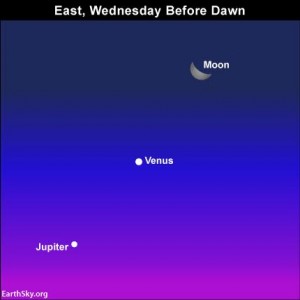
Coming up soon! The bow of the waning crescent moon points toward Venus and Jupiter before sunrise on Wednesday, October 7. Read more
The most noticeable planet this month is dazzling Venus in the east before dawn. Look in the direction of sunrise as dawn begins to light the sky. Next, in that same part of the sky, you’ll notice Jupiter, second-brightest planet. Fainter Mars is also in the morning sky beneath Venus. Saturn is the lone evening planet this month, setting at early evening from mid-northern latitudes and at mid-evening from temperate latitudes in the Southern Hemisphere. Mercury will make a fine appearance in the morning sky for the Northern Hemisphere for a few weeks, centered on mid-October. Follow the links below to learn more about October planets.
Sole evening planet in October 2015
Saturn visible at nightfall and early evening
Morning planets in October 2015
Brilliant Venus in the east before sunrise
Mars between Venus and Jupiter before sunrise
Bright Jupiter below Venus and Mars in morning sky
Mercury at early dawn, better from Northern Hemisphere
Like what EarthSky offers? Sign up for our free daily newsletter today!
Astronomy events, star parties, festivals, workshops for September-December, 2015
Saturn visible at nightfall and early evening. Throughout October 2015, the golden planet Saturn pops into view at nightfall, though quite low in the southwest sky from mid-northern latitudes. At northerly latitudes, Saturn sets at early evening in early October and at nightfall by the month’s end. At temperate latitudes in the Southern Hemisphere, Saturn sets at mid-to-late evening in early October and early evening in late October.
From all around the world, Saturn is sinking toward the glare of sunset all month long. Saturn will disappear from the evening sky in November 2015 and will reappear in the morning sky in December 2015.
How can you recognize this wonderful planet? It’s golden in color, to the eye. It shines with a steady light. Check the chart above for dates when Saturn will appear near the moon this month. If you can identify Saturn, near the moon, and notice the nearby ruddy star Antares, you’ll be able to spot and identify Saturn and Antares when the moon has moved away.
Binoculars don’t reveal Saturn’s gorgeous rings, by the way. For that, you need a small telescope. But binoculars will enhance Saturn’s golden color and Antares’ reddish complexion.
Saturn’s rings are inclined at about 25o from edge-on in October 2015, exhibiting their northern face. A few years from now, in October 2017, the rings will open most widely, displaying a maximum inclination of 27o. As with so much in space (and on Earth), the appearance of Saturn’s rings from Earth is cyclical. In the year 2025, the rings will appear edge-on as seen from Earth. After that, we’ll begin to see the south side of Saturn’s rings, to increase to a maximum inclination of 27o by May, 2032.

The waning crescent moon swings by the morning planets Venus, Mars, Jupiter and Mercury – in the second week of October. The green line depicts the ecliptic – the pathway of the moon and planets. Read more.
Brilliant Venus in the east before sunrise. Here’s a very fun observation to make this month: Venus before dawn. Venus is the brightest planet and third-brightest sky object overall, after the sun and moon. When it’s visible, it’s very, very prominent in our sky.
Moreover, this dazzling world will enable you to locate the fainter yet relatively nearby planets Mars and Jupiter in the morning sky. Be sure to use the waning crescent moon to locate Venus (plus Mars and Jupiter) in the morning sky on October 7, October 8 and October 9.
You won’t want to miss Venus and the early morning planets, especially in late October. Venus, Mars and Jupiter all meet up in the last week of October to present the closest grouping of three planets until January of 2021. And if you live in the tropics and the Northern Hemisphere, you can also see Mercury below this planetary trio.
Planetary trio lights up morning sky in late October 2015

Jupiter will be in conjunction with Mars on October 17, 2015. If you have trouble seeing Mars in the morning sky, aim them at Jupiter to spot Mars nearby. Mars and Jupiter will share the same binocular field from about October 12 to nearly the end of the month.. Read more.
Mars between Venus and Jupiter before sunrise. Mars is nowhere as bright as the more prominent morning planets, Venus and Jupiter, which rank as the third-brightest and fourth-brightest celestial bodies, respectively, after the sun and moon. Even so, modestly-bright Mars is easily visible in the predawn sky. Simply draw and imaginary line from Venus to Jupiter to locate Mars in between these two brilliant worlds.
Day by day, Jupiter climbs upward toward Mars. Jupiter will finally meet up with Mars for a close-knit conjunction on October 17. After that, Jupiter will continue to climb upward, away from Mars, to have a conjunction with Venus on October 26. This date, October 26, also marks Venus’ greatest morning elongation from the sun, and moreover, features the closest grouping of three planets since May 27, 2013. Another grouping of three planets won’t happen again until January 10, 2021. All three worlds – Venus, Jupiter and Mars – will fit within the same binocular field, so be sure to circle October 26 on your calendar.
Let the waning crescent moon help guide your eye to Mars in the morning sky for several days, centered on or near October 9.
Mars will continue to brighten month by month, until the Red Planet culminates in brightness in May, 2016. Believe it or not, Mars will be more brilliant then than Jupiter is now!

From the Northern Hemisphere, Mercury should be in fine view around mid-month. Draw an imaginary line from Venus through Jupiter to find Mercury near the horizon. Binoculars may be helpful! Read more
Jupiter starts out the month below Venus and Mars. Keep watching, though, and witness Jupiter’s quick ascent upward, toward Mars and Venus. Jupiter will catch up with Mars on
October 17, to exhibit their first conjunction since July 22, 2013. The next conjunction of Mars and Jupiter won’t be forthcoming until until January 7, 2018.
Then Jupiter will head toward Venus, showcasing their third and final conjunction of the year in the morning sky on October 26.
By a wonderful coincidence, as Venus and Jupiter show off their final conjunction of the year – on October 26 – Venus will reach its greatest western (morning) elongation from the sun.
Moreover, the year’s closest grouping of three planets – Venus, Mars and Jupiter – will also take place on October 26. That’s a big deal because the next planetary trio won’t occur again until January, 2021!
The waning crescent moon shines close to Venus for several mornings, centered around October 8.
If you have binoculars or a telescope, it’s fairly easy to see Jupiter’s four major moons, which look like pinpricks of light on or near the same plane. They are often called the Galilean moons to honor Galileo, who discovered these great Jovian moons in 1610. In their order from Jupiter, these moons are Io, Europa, Ganymede and Callisto. In September of 2015, however, Jupiter’s moons will have a hard time competing with the sun’s glare in the morning sky.
These moons circle Jupiter around the Jovian equator. In cycles of six years, we view Jupiter’s equator edge-on. So, in 2015, we got to view a number of mutual events involving Jupiter’s moons through a high-powered telescope. Click here or here or here for more details.
Click here for a Jupiter’s moons almanac, courtesy of Sky & Telescope.

Circle October 10 and 11 on your calendar. That’s when you have the opportunity to view the waning crescent moon and Mercury coupling up in the eastern sky at morning dawn. May you be blessed with clear skies! Read more
Mercury at early dawn, better from Northern Hemisphere. Mercury is our solar system’s innermost planet and always stays near the sun in our sky. This planet passed out of the evening sky and into the morning sky on September 30, 2015. From the Northern Hemisphere and southern tropics, you might first see the waning crescent moon near Mercury in the morning sky on October 10 or 11. Mercury will be easier to spot when it’s at its greatest elongation from the sun on October 16.
It’ll be a real challenge to catch Mercury from southerly latitudes, however. This world sits close the the glare of sunrise all month.
For the Northern Hemisphere, October presents Mercury’s best appearance in the morning sky for all 2015. At mid-month, Mercury rises some 90 minutes before sunrise at mid-northern latitudes, and the innermost planet should remain in good view for another week or so after that – or around the time of the Orionid meteor shower.
Look for Mercury over the sunrise point on the horizon as darkness gives way to dawn. Click here for recommended almanacs. They can help you find Mercury’s rising time in your sky, and for the time at which astronomical twilight begins.
Those residing at temperate latitudes in the Southern Hemisphere aren’t as lucky this month. In that part of the world, Mercury – even at its best – rises less than one hour before the sun. From southerly latitudes, the innermost planet will be hard to catch even with binoculars in the glare of dawn. However, binoculars are always recommended to enhance sky views!
Mercury will stay in the morning sky until November 17, 2015. Then it’ll pass into the evening sky, to give both hemispheres a decent evening apparition of Mercury in late December 2015.
Click here for recommended almanacs. They can help you know when Mercury rises in your sky
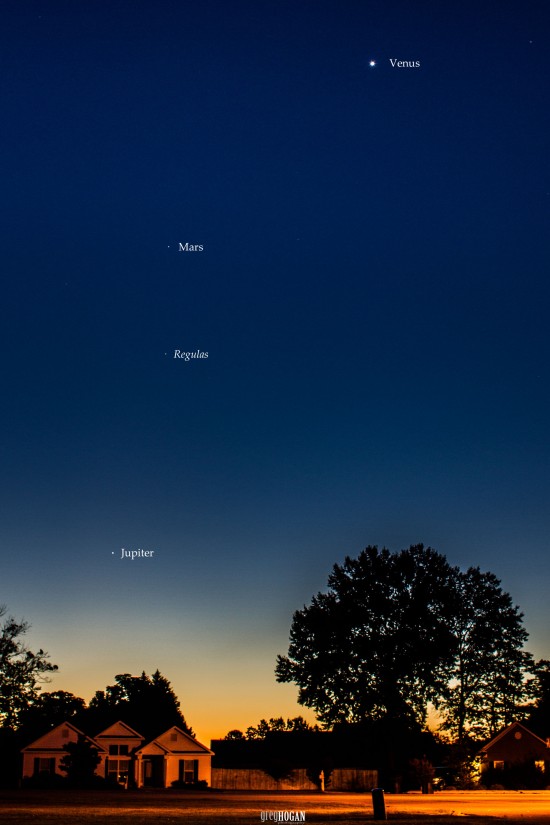
Eastern sky before dawn now. Photo taken September 18, 2015 and submitted to EarthSky by Greg Hogan in Kathleen, Georgia. Thanks, Greg!
What do we mean by visible planet? By visible planet, we mean any solar system planet that is easily visible without an optical aid and that has been watched by our ancestors since time immemorial. In their outward order from the sun, the five visible planets are Mercury, Venus, Mars, Jupiter and Saturn. These planets are visible in our sky because their disks reflect sunlight, and these relatively nearby worlds tend to shine with a steadier light than the distant, twinkling stars. They tend to be bright! You can spot them, and come to know them as faithful friends, if you try.
Bottom line: In October 2015, Saturn is the lone evening planet, appearing in the southwest at nightfall. Venus, Mars and Jupiter convene in the eastern predawn sky, with Mercury joining the morning planets possibly as early as October 10.

View larger. Evening dusk on August 5: Venus at left. Mercury is climbing higher, toward Regulus (at top) and Jupiter (beneath Regulus).

By the evening of July 12, Venus and Jupiter were farther apart and lower in the western sky after sunset. Photo by Robert Kelly. Thanks, Robert!
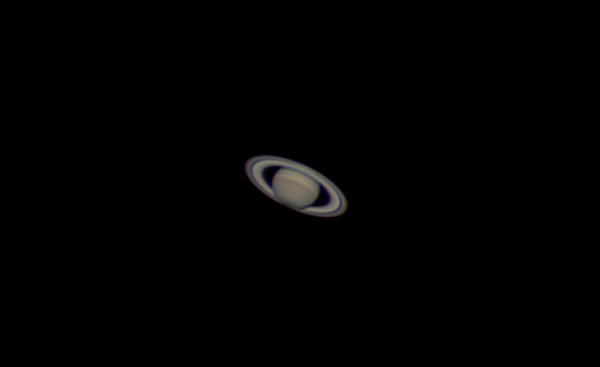
Photo taken June 13, 2015 by John Nelson at Puget Sound, Washington. Thanks, John!
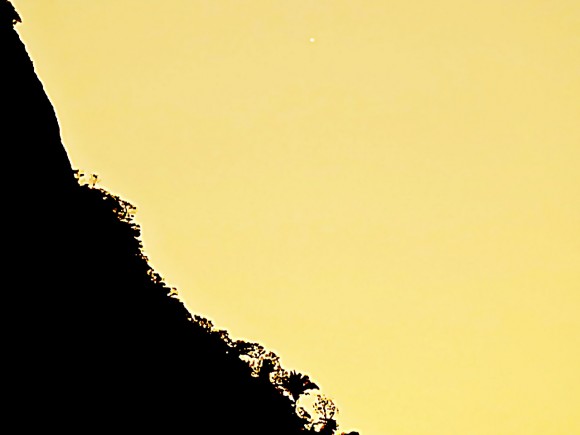
View larger.| Venus near the setting sun on November 18, 2014 by Helio de Carvalho Vital in Rio de Janeiro, Brazil. He wrote, “I managed to capture Venus as it is starting its return to dusk, despite the fact that it is still at a mere 6.2° distance from the sun. The photos show it a few minutes before setting behind the northern side of the 1,021-meter high Tijuca Peak, located some 6.5 km away. It was deeply immersed in the intense glare of the sun, that would set some 13 minutes later.”
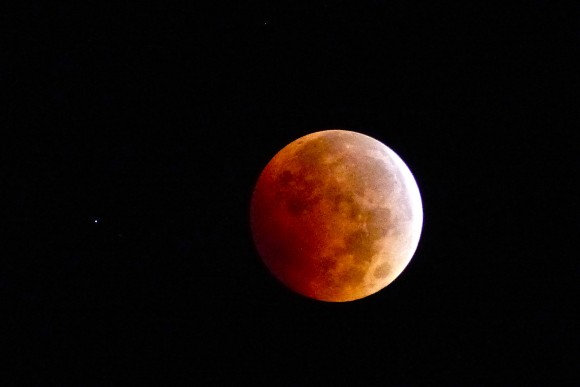
Lunar eclipse on the night of October 8, 2014. The object to the left is the planet Uranus! This beautiful photo is by Janey Wing Kenyon of Story, Wyoming.
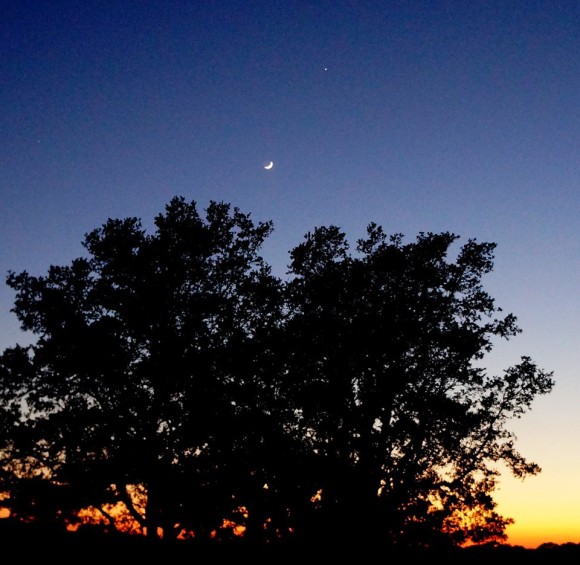
Debra Fryar in Calobreves, Texas captured this photo of the moon and Jupiter on May 31, 2014. Jupiter was close to the twilight then.
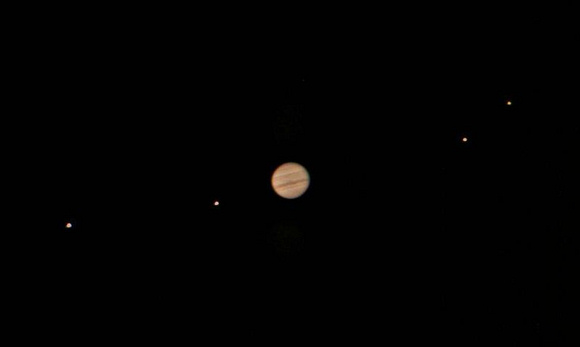
With only a modest backyard telescope, you can easily see Jupiter’s four largest moons. Here they are through a 10″ (25 cm) Meade LX200 telescope. Image credit: Jan Sandberg
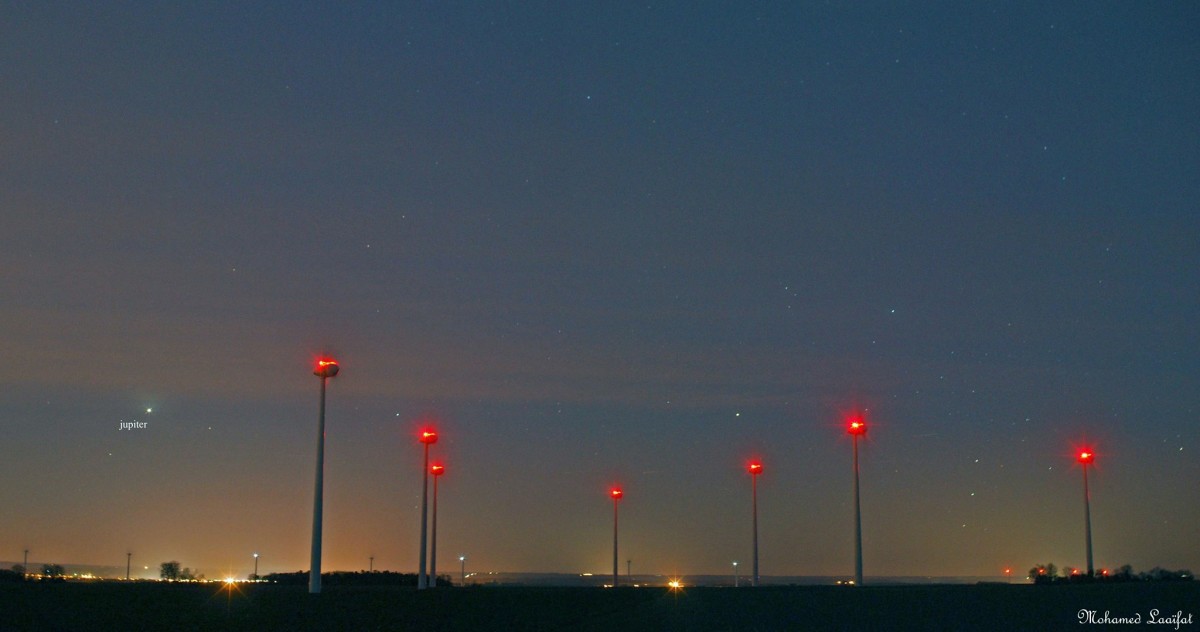
Jupiter was rivaling the streetlights, when Mohamed Laaifat Photographies captured this photo in Normandy, France. Visit his page on Facebook.

Venus by Danny Crocker-Jensen
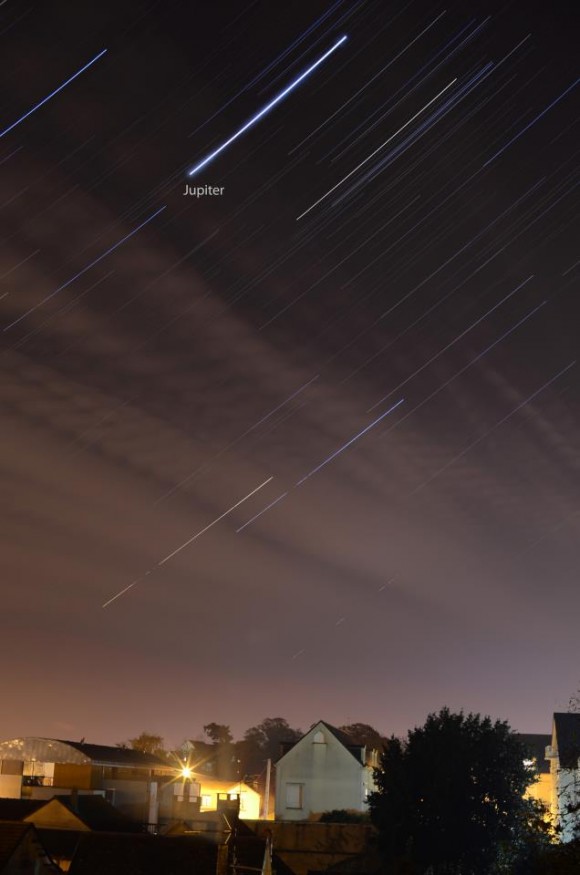
These are called star trails. It’s a long-exposure photo, which shows you how Earth is turning under the stars. The brightest object here is Jupiter, which is the second-brightest planet, after Venus. This awesome photo by EarthSky Facebook friend Mohamed Laaifat in Normandy, France. Thank you, Mohamed.

Skywatcher, by Predrag Agatonovic.
Easily locate stars and constellations with EarthSky’s planisphere.
Don’t miss anything. Subscribe to EarthSky News by email
from EarthSky http://ift.tt/IJfHCr


Coming up soon! The bow of the waning crescent moon points toward Venus and Jupiter before sunrise on Wednesday, October 7. Read more
The most noticeable planet this month is dazzling Venus in the east before dawn. Look in the direction of sunrise as dawn begins to light the sky. Next, in that same part of the sky, you’ll notice Jupiter, second-brightest planet. Fainter Mars is also in the morning sky beneath Venus. Saturn is the lone evening planet this month, setting at early evening from mid-northern latitudes and at mid-evening from temperate latitudes in the Southern Hemisphere. Mercury will make a fine appearance in the morning sky for the Northern Hemisphere for a few weeks, centered on mid-October. Follow the links below to learn more about October planets.
Sole evening planet in October 2015
Saturn visible at nightfall and early evening
Morning planets in October 2015
Brilliant Venus in the east before sunrise
Mars between Venus and Jupiter before sunrise
Bright Jupiter below Venus and Mars in morning sky
Mercury at early dawn, better from Northern Hemisphere
Like what EarthSky offers? Sign up for our free daily newsletter today!
Astronomy events, star parties, festivals, workshops for September-December, 2015
Saturn visible at nightfall and early evening. Throughout October 2015, the golden planet Saturn pops into view at nightfall, though quite low in the southwest sky from mid-northern latitudes. At northerly latitudes, Saturn sets at early evening in early October and at nightfall by the month’s end. At temperate latitudes in the Southern Hemisphere, Saturn sets at mid-to-late evening in early October and early evening in late October.
From all around the world, Saturn is sinking toward the glare of sunset all month long. Saturn will disappear from the evening sky in November 2015 and will reappear in the morning sky in December 2015.
How can you recognize this wonderful planet? It’s golden in color, to the eye. It shines with a steady light. Check the chart above for dates when Saturn will appear near the moon this month. If you can identify Saturn, near the moon, and notice the nearby ruddy star Antares, you’ll be able to spot and identify Saturn and Antares when the moon has moved away.
Binoculars don’t reveal Saturn’s gorgeous rings, by the way. For that, you need a small telescope. But binoculars will enhance Saturn’s golden color and Antares’ reddish complexion.
Saturn’s rings are inclined at about 25o from edge-on in October 2015, exhibiting their northern face. A few years from now, in October 2017, the rings will open most widely, displaying a maximum inclination of 27o. As with so much in space (and on Earth), the appearance of Saturn’s rings from Earth is cyclical. In the year 2025, the rings will appear edge-on as seen from Earth. After that, we’ll begin to see the south side of Saturn’s rings, to increase to a maximum inclination of 27o by May, 2032.

The waning crescent moon swings by the morning planets Venus, Mars, Jupiter and Mercury – in the second week of October. The green line depicts the ecliptic – the pathway of the moon and planets. Read more.
Brilliant Venus in the east before sunrise. Here’s a very fun observation to make this month: Venus before dawn. Venus is the brightest planet and third-brightest sky object overall, after the sun and moon. When it’s visible, it’s very, very prominent in our sky.
Moreover, this dazzling world will enable you to locate the fainter yet relatively nearby planets Mars and Jupiter in the morning sky. Be sure to use the waning crescent moon to locate Venus (plus Mars and Jupiter) in the morning sky on October 7, October 8 and October 9.
You won’t want to miss Venus and the early morning planets, especially in late October. Venus, Mars and Jupiter all meet up in the last week of October to present the closest grouping of three planets until January of 2021. And if you live in the tropics and the Northern Hemisphere, you can also see Mercury below this planetary trio.
Planetary trio lights up morning sky in late October 2015

Jupiter will be in conjunction with Mars on October 17, 2015. If you have trouble seeing Mars in the morning sky, aim them at Jupiter to spot Mars nearby. Mars and Jupiter will share the same binocular field from about October 12 to nearly the end of the month.. Read more.
Mars between Venus and Jupiter before sunrise. Mars is nowhere as bright as the more prominent morning planets, Venus and Jupiter, which rank as the third-brightest and fourth-brightest celestial bodies, respectively, after the sun and moon. Even so, modestly-bright Mars is easily visible in the predawn sky. Simply draw and imaginary line from Venus to Jupiter to locate Mars in between these two brilliant worlds.
Day by day, Jupiter climbs upward toward Mars. Jupiter will finally meet up with Mars for a close-knit conjunction on October 17. After that, Jupiter will continue to climb upward, away from Mars, to have a conjunction with Venus on October 26. This date, October 26, also marks Venus’ greatest morning elongation from the sun, and moreover, features the closest grouping of three planets since May 27, 2013. Another grouping of three planets won’t happen again until January 10, 2021. All three worlds – Venus, Jupiter and Mars – will fit within the same binocular field, so be sure to circle October 26 on your calendar.
Let the waning crescent moon help guide your eye to Mars in the morning sky for several days, centered on or near October 9.
Mars will continue to brighten month by month, until the Red Planet culminates in brightness in May, 2016. Believe it or not, Mars will be more brilliant then than Jupiter is now!

From the Northern Hemisphere, Mercury should be in fine view around mid-month. Draw an imaginary line from Venus through Jupiter to find Mercury near the horizon. Binoculars may be helpful! Read more
Jupiter starts out the month below Venus and Mars. Keep watching, though, and witness Jupiter’s quick ascent upward, toward Mars and Venus. Jupiter will catch up with Mars on
October 17, to exhibit their first conjunction since July 22, 2013. The next conjunction of Mars and Jupiter won’t be forthcoming until until January 7, 2018.
Then Jupiter will head toward Venus, showcasing their third and final conjunction of the year in the morning sky on October 26.
By a wonderful coincidence, as Venus and Jupiter show off their final conjunction of the year – on October 26 – Venus will reach its greatest western (morning) elongation from the sun.
Moreover, the year’s closest grouping of three planets – Venus, Mars and Jupiter – will also take place on October 26. That’s a big deal because the next planetary trio won’t occur again until January, 2021!
The waning crescent moon shines close to Venus for several mornings, centered around October 8.
If you have binoculars or a telescope, it’s fairly easy to see Jupiter’s four major moons, which look like pinpricks of light on or near the same plane. They are often called the Galilean moons to honor Galileo, who discovered these great Jovian moons in 1610. In their order from Jupiter, these moons are Io, Europa, Ganymede and Callisto. In September of 2015, however, Jupiter’s moons will have a hard time competing with the sun’s glare in the morning sky.
These moons circle Jupiter around the Jovian equator. In cycles of six years, we view Jupiter’s equator edge-on. So, in 2015, we got to view a number of mutual events involving Jupiter’s moons through a high-powered telescope. Click here or here or here for more details.
Click here for a Jupiter’s moons almanac, courtesy of Sky & Telescope.

Circle October 10 and 11 on your calendar. That’s when you have the opportunity to view the waning crescent moon and Mercury coupling up in the eastern sky at morning dawn. May you be blessed with clear skies! Read more
Mercury at early dawn, better from Northern Hemisphere. Mercury is our solar system’s innermost planet and always stays near the sun in our sky. This planet passed out of the evening sky and into the morning sky on September 30, 2015. From the Northern Hemisphere and southern tropics, you might first see the waning crescent moon near Mercury in the morning sky on October 10 or 11. Mercury will be easier to spot when it’s at its greatest elongation from the sun on October 16.
It’ll be a real challenge to catch Mercury from southerly latitudes, however. This world sits close the the glare of sunrise all month.
For the Northern Hemisphere, October presents Mercury’s best appearance in the morning sky for all 2015. At mid-month, Mercury rises some 90 minutes before sunrise at mid-northern latitudes, and the innermost planet should remain in good view for another week or so after that – or around the time of the Orionid meteor shower.
Look for Mercury over the sunrise point on the horizon as darkness gives way to dawn. Click here for recommended almanacs. They can help you find Mercury’s rising time in your sky, and for the time at which astronomical twilight begins.
Those residing at temperate latitudes in the Southern Hemisphere aren’t as lucky this month. In that part of the world, Mercury – even at its best – rises less than one hour before the sun. From southerly latitudes, the innermost planet will be hard to catch even with binoculars in the glare of dawn. However, binoculars are always recommended to enhance sky views!
Mercury will stay in the morning sky until November 17, 2015. Then it’ll pass into the evening sky, to give both hemispheres a decent evening apparition of Mercury in late December 2015.
Click here for recommended almanacs. They can help you know when Mercury rises in your sky

Eastern sky before dawn now. Photo taken September 18, 2015 and submitted to EarthSky by Greg Hogan in Kathleen, Georgia. Thanks, Greg!
What do we mean by visible planet? By visible planet, we mean any solar system planet that is easily visible without an optical aid and that has been watched by our ancestors since time immemorial. In their outward order from the sun, the five visible planets are Mercury, Venus, Mars, Jupiter and Saturn. These planets are visible in our sky because their disks reflect sunlight, and these relatively nearby worlds tend to shine with a steadier light than the distant, twinkling stars. They tend to be bright! You can spot them, and come to know them as faithful friends, if you try.
Bottom line: In October 2015, Saturn is the lone evening planet, appearing in the southwest at nightfall. Venus, Mars and Jupiter convene in the eastern predawn sky, with Mercury joining the morning planets possibly as early as October 10.

View larger. Evening dusk on August 5: Venus at left. Mercury is climbing higher, toward Regulus (at top) and Jupiter (beneath Regulus).

By the evening of July 12, Venus and Jupiter were farther apart and lower in the western sky after sunset. Photo by Robert Kelly. Thanks, Robert!

Photo taken June 13, 2015 by John Nelson at Puget Sound, Washington. Thanks, John!

View larger.| Venus near the setting sun on November 18, 2014 by Helio de Carvalho Vital in Rio de Janeiro, Brazil. He wrote, “I managed to capture Venus as it is starting its return to dusk, despite the fact that it is still at a mere 6.2° distance from the sun. The photos show it a few minutes before setting behind the northern side of the 1,021-meter high Tijuca Peak, located some 6.5 km away. It was deeply immersed in the intense glare of the sun, that would set some 13 minutes later.”

Lunar eclipse on the night of October 8, 2014. The object to the left is the planet Uranus! This beautiful photo is by Janey Wing Kenyon of Story, Wyoming.

Debra Fryar in Calobreves, Texas captured this photo of the moon and Jupiter on May 31, 2014. Jupiter was close to the twilight then.

With only a modest backyard telescope, you can easily see Jupiter’s four largest moons. Here they are through a 10″ (25 cm) Meade LX200 telescope. Image credit: Jan Sandberg

Jupiter was rivaling the streetlights, when Mohamed Laaifat Photographies captured this photo in Normandy, France. Visit his page on Facebook.

Venus by Danny Crocker-Jensen

These are called star trails. It’s a long-exposure photo, which shows you how Earth is turning under the stars. The brightest object here is Jupiter, which is the second-brightest planet, after Venus. This awesome photo by EarthSky Facebook friend Mohamed Laaifat in Normandy, France. Thank you, Mohamed.

Skywatcher, by Predrag Agatonovic.
Easily locate stars and constellations with EarthSky’s planisphere.
Don’t miss anything. Subscribe to EarthSky News by email
from EarthSky http://ift.tt/IJfHCr
